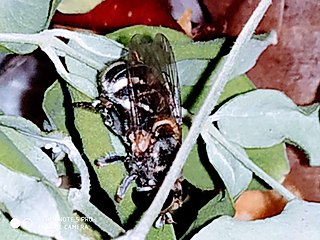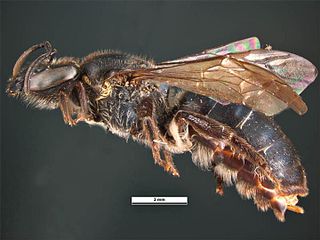Hylaeus sedens is a bee species endemic to Asia.
Lasioglossum semisculptum, also known as the Lasioglossum (Ctenomia) semisculptum, is a species of bee in the genus Lasioglossum, of the family Halictidae. Lasioglossum semisculptum exhibits a high degree of social diversity, ranging from solitary to eusocial behaviors. These bees are important pollinators for a variety of wildflowers and crops, contributing significantly to the biodiversity and health of ecosystems.
Lasioglossum vagans, also known as the Lasioglossum (Ctenomia) vagans, is a species of bee in the family Halictidae.
Lasioglossum serenum, also known as the Lasioglossum (Nesohalictus) serenum, is a species of bee in the genus Lasioglossum, of the family Halictidae.
Lasioglossum alphenum, also known as the Lasioglossum (Sudila) alphenum by Sakagami et al. (1996), is a species of bee in the genus Lasioglossum, of the family Halictidae.

Pseudapis oxybeloides is a species of soil-nesting bee in the genus Pseudapis. of the family Halictidae, and a major global pollinator.
Steganomus nodicornis is a species of bee in the genus Steganomus, of the family Halictidae.
Anthidiellum butarsis is a species of leaf-cutting bee in the genus Anthidiellum, of the family Megachilidae.
Anthidiellum krombeini is a species of leaf-cutting bee in the genus Anthidiellum, of the family Megachilidae.
Coelioxys angulata is a species of leaf-cutting bee in the genus Coelioxys, of the family Megachilidae.
Coelioxys fuscipennis is a species of leaf-cutting bee in the genus Coelioxys, of the family Megachilidae. It is found in India, and recordings from Sri Lanka is uncertain.
Coelioxys nitidoscutellaris is a species of leaf-cutting bee in the genus Coelioxys, of the family Megachilidae.
Coelioxys formosicola is a species of leaf-cutting bee in the genus Coelioxys, of the family Megachilidae.
Braunsapis flaviventris is a species of bee belonging to the family Apidae subfamily Xylocopinae.
Nomada priscilla, is a species of bee belonging to the family Apidae subfamily Nomadinae. It is found in Sri Lanka, India and Philippines.
Tetraloniella taprobanicola, also known as Tetraloniella (Tetraloniella) taprobanicola, is a species of bee belonging to the family Apidae subfamily Apinae. It is found endemic to Sri Lanka.
Thyreus insignis, is a species of bee belonging to the family Apidae subfamily Apinae.
Thyreus surniculus, is a species of bee belonging to the family Apidae subfamily Apinae. It is found in India, Sri Lanka and occasionally Pakistan.
Thyreus takaonis, is a species of bee belonging to the family Apidae subfamily Apinae.

Lasioglossum halictoides, also known as the Lasioglossum (Australictus) davide , is a species of bee in the subgenus Australictus of the genus Lasioglossum, in the Halictidae family. It was first described in 1910 by Theodore Dru Alison Cockerell as Halictus davidis, from a specimen collected at Kuranda, Queensland.


